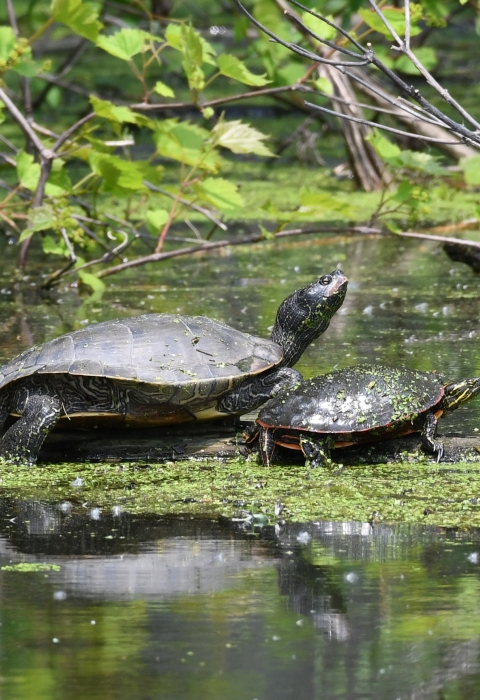Seasons of Wildlife
Spring
Migrating shorebirds, waterfowl and songbirds stop on their way to northern breeding grounds. Louisa Division trails and the Keithsburg levee are the best places to see colorful warblers and other songbirds before leaves fully emerge on trees. Migrating waterfowl can also be seen from trails.
Summer
As water is drawn down on the Louisa Division, wading birds are abundant and later in the summer shorebirds again appear on their way to the wintering grounds. Wood duck and hooded merganser broods appear. Bitterns and rails are often heard. Frogs and turtles are abundant.
Fall
Large flocks of waterfowl stop to rest and refuel while traveling to their southern wintering grounds. A great variety of dabbling and diving ducks are present, as well as thousands of geese. Although much of the refuge is closed during the migration to allow waterfowl to feed and rest, there are opportunities to view waterfowl. Contact the refuge for locations and dates.
Winter
Large numbers of bald eagles winter in the Mississippi River corridor and can be seen roosting in shoreline trees and feeding where open-water conditions exist. Deer are commonly seen.
Year round
Some species can be found on the refuge at all times of the year. Wild turkeys, northern bobwhite quail, pileated woodpeckers, northern cardinals, hairy woodpeckers, Carolina wrens, tufted titmice and great horned owls are year round residents.
Featured Species
Each spring and fall the refuge serves as an important stopover for waterfowl and other migratory birds. Spectacular seasonal flights with thousands of mallards, pintails, wigeons, blue and green-winged teals, shovelers, gadwalls, canvasbacks and geese are commonly seen. Mudflats and shallow water habitats host herons, egrets and shorebirds. Marshy areas provide habitat for rails and bitterns.
Refuge forests and grasslands are home to many colorful songbirds that spend the winter in Central and South America and then migrate north for the summer breeding season. Some of these birds use refuge lands as stopover areas for resting and feeding during their journeys north and south. Others stay to nest and raise their young. Warblers and other birds are especially brilliant and vocal in the spring. The refuge trails on the Louisa Division are a great place to see these birds that use both forest and grassland habitat.
The refuge is part of a state designated reptile and amphibian conservation area conservation area
A conservation area or wildlife management area is a type of national wildlife refuge that consists primarily or entirely of conservation easements on private lands. These conservation easements support private landowner efforts to protect important habitat for fish and wildlife. There are 13 conservation areas and nine wildlife management areas in the National Wildlife Refuge System.
Learn more about conservation area in southeast Iowa. Many snakes, turtles, frogs and toads use the variety of habitats the refuge provides. Turtles are commonly seen basking on logs, and frogs and toads are abundant. The refuge is home to some state threatened and endangered snake species. The copperbelly water snake uses the wetland scrub-shrub habitats and the diamondback water snake uses wetland habitats. There are no poisonous snakes on the refuge.
